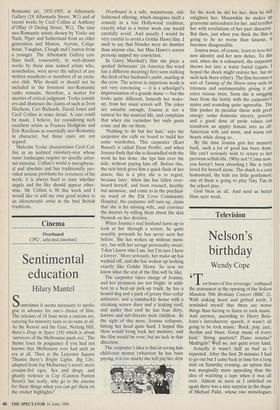Exhibitions
Cecil Collins (Anthony d'Offay, till 23 June)
Country roots
Giles Auty
When I was a small boy living in the country, rural lads thought themselves superior to town boys in more or less everything that mattered. Affairs of con- sequence, in our opinion, included fishing, hunting rats and rabbits, climbing trees and being able to identify most wild-life in- stantly. City children with whom we came in contact were generally frightened of cows and horses, darkness and the sounds of the countryside at night — especially John Minton's 'The Harbour Master', 1947 those made by owls. By contrast, local village boys kept owls or jackdaws as family. pets. One such jackdaw flew daily alongside the train carrying its owner to and from school. During class-time the loyal bird perched patiently in a tree in the playground. Yet by the time I had grown up, a complete reversal had occurred. By then, young yokels, far from attracting the average city-dweller's respect, had become keen only to ape the more unattractive habits of their urban counterparts. During the past 25 years this phenomenon has possibly accelerated, as recent press re- ports confirm.
Whether by coincidence or otherwise, the reversal in patterns of esteem between country and city dwellers has been mir- rored with rare chronological exactness in art. The neo-Romantic movement in Bri- tain, the last such to seek stimulus openly from nature and the countryside, was already well past its apogee by 1951, the year of the Festival of Britain. Ever since that time, more urban and cerebral move- ments have followed in steady succession — Kitchen Sink, Abstract Expressionism, Pop, Minimalism, Conceptualism etc with neglected nature never getting a look-in. Unlike neo-Romanticism, the more urban-based movements have been claimed as contributors to what has often been a bogus internationalism. Neo- Romanticism is based squarely on indige- nous traditions, interests and artists: on Blake, Turner and Palmer especially but also on such as Bonington, Ward and Calvert. Wordsworth, Coleridge, Eliot and Thomas provide typical poetic antecedents and significantly the movement had no direct Continental or transatlantic counter- part.
In the eyes of our present-generation art historians, who take their cue from Roger Fry in their ostensible contempt for the home-produced, this factor condemns neo- Romanticism automatically to unimportant 'provincialism'. Provincial has now re- placed philistine as the most damning epithet likely to pass the lips of our modern museum hierarchy. Significantly, all evi- dence of neo-Romanticism was excluded from British Art in the 20th Century, the Royal Academy's giant survey show of 1987. Reasoning runs that anything rooted in love for or interest in the country cannot be sufficiently 'modern' and hence 'inter- national'; game, set and match to our city-based rulers.
Happily the able historian Malcolm Yorke continues to argue the case for the importance of neo-Romanticism in his excellent new book The Spirit of Place: nine neo-Romantic artists and their times (Constable, £20). This together with Wil- liam Anderson's Cecil Collins (Barrie & Jenkins, £25), which I will be reviewing next week in the literary section, is one of the adornments of recent art publishing. Publication of these books is marked by complementary exhibitions of neo- Romantic art, 1935-1955, at Albemarle Gallery (18 Albemarle Street, W1) and of recent works by Cecil Collins at Anthony d'Offay (9 Dering Street, W1). The nine neo-Romantic artists chosen by Yorke are Nash, Piper and Sutherland from an older generation and Minton, Ayrton, Colqu- houn, Vaughan, Clough and Craxton from a younger. The Albemarle Gallery con- fines itself, reasonably, to well-chosen works by these nine named artists who, nonetheless, were never the subject of any written manifesto or members of an exclu- sive club. Who should or should not be included in the foremost neo-Romantic ranks remains, therefore, a matter for niceties of critical judgment. Yorke consid- ers and dismisses the claims of such as Ivon Hitchens, Ceri Richards, David Jones and Cecil Collins in some detail. A case could be made, I believe, for considering such excellent artists as Frances Hodgkins and Eric Ravilious as essentially neo-Romantic in character, but these cases are not argued.
Malcolm Yorke characterises Cecil Col- lins as an isolated visionary-seer whose inner landscapes require no specific exter- nal stimulus. Collins's world is metaphysic- al and absolute and has traditionally pro- vided serious problems for reviewers of his work: it is always hard to state whether angels and the like should appear other- wise. Mr Collins is 80 this week and I would like to add my own good wishes to an idiosyncratic artist in the best British traditions.



















































 Previous page
Previous page